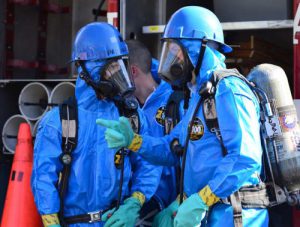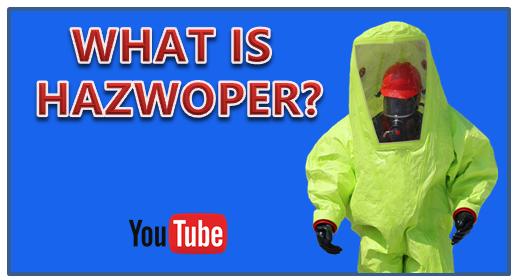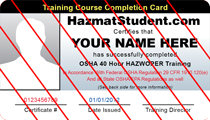| On the Level | OSHA Training Levels for Emergency Responders |
When a hazardous substance release occurs, emergency responders must know, inside and out, what their responsibilities are and be ready to take the appropriate actions. If workers take actions they haven’t been properly trained to perform, many people’s safety and lives could be put at risk. It’s critical that emergency response personnel get the proper level of OSHA-required training, based on their job responsibilities during hazardous waste operations.
Level 1 – First Responder Awareness (FRA)
Workers who may witness or discover a release of hazardous substances and who are responsible for notifying the proper authorities, need to be trained to the First Responder Awareness Level. These workers would take no further action beyond notifying the authorities of the release. This training level does not have a specific time requirement for the length of training, but requiressufficient training or experience for the worker to demonstrate the below competencies. An annual refresher is also required.

- An understanding of what hazardous substances are, and the risks associated with them in an incident.
- An understanding of the potential outcomes associated with an emergency created when hazardous substances are present.
- The ability to recognize the presence of hazardous substances in an emergency.
- The ability to identify the hazardous substances, if possible.
- An understanding of the role of the first responder awareness individual in the employer’s emergency response plan including site security and control and the U.S. Department of Transportation’s Emergency Response Guidebook.
- The ability to realize the need for additional resources, and to make appropriate notifications to the communication center.
29 CFR 1910.120(q)(6)(i)
Level 2 – First Responder Operations (FRO)
Workers who respond to hazardous substance releases (or potential releases) in a defensive manner, but do not try to stop the release, need to be trained to the First Responder Operations Level. These workers aim to contain the release from a safe distance, keep it from spreading, and prevent exposures. They work to protect people, property and the environment from the effects of the release. This training level requires 8 hours of initial training or sufficient experience to demonstrate the below competencies. An annual refresher is also required.
- Knowledge of the basic hazard and risk assessment techniques.
- Know how to select and use proper personal protective equipment provided to the first responder operational level.
- An understanding of basic hazardous materials terms.
- Know how to perform basic control, containment and/or confinement operations within the capabilities of the resources and personal protective equipment available with their unit.
- Know how to implement basic decontamination procedures.
- An understanding of the relevant standard operating procedures and termination procedures.
29 CFR 1910.120(q)(6)(ii)
Level 3 – Hazardous Materials Technician
Hazardous materials technicians will approach the point of a hazardous substance release (or potential release) and take action to plug, patch, or otherwise stop the release. Because this role is more aggressive and potentially more dangerous than the operations level, workers at the Hazmat Tech level are required to receive 24 hours of operations level training and have competency in the below areas. Annual refresher training is also required.
- Know how to implement the employer’s emergency response plan.
- Know the classification, identification and verification of known and unknown materials by using field survey instruments and equipment.
- Be able to function within an assigned role in the Incident Command System.
- Know how to select and use proper specialized chemical personal protective equipment provided to the hazardous materials technician.
- Understand hazard and risk assessment techniques.
- Be able to perform advance control, containment, and/or confinement operations within the capabilities of the resources and personal protective equipment available with the unit.
- Understand and implement decontamination procedures.
- Understand termination procedures.
- Understand basic chemical and toxicological terminology and behavior.
29 CFR 1910.120(q)(6)(iii)
Level 4 – Hazardous Materials Specialist
Hazmat Specialists parallel the duties of Hazmat Techs, but they also need to have a more directed or specific knowledge about various substances they may need to contain. Hazmat Specialists also act as the site liaison with Federal, state, local, and other government authorities regarding site activities. Hazmat Specialists are required to receive 24 hours of technician level training, plus have the below competencies. Annual refresher training is required.
- Know how to implement the local emergency response plan.
- Understand classification, identification and verification of known and unknown materials by using advanced survey instruments and equipment.
- Know the state emergency response plan.
- Be able to select and use proper specialized chemical personal protective equipment provided to the hazardous materials specialist.
- Understand in-depth hazard and risk techniques.
- Be able to perform specialized control, containment, and/or confinement operations within the capabilities of the resources and personal protective equipment available.
- Be able to determine and implement decontamination procedures.
- Have the ability to develop a site safety and control plan.
- Understand chemical, radiological and toxicological terminology and behavior.
29 CFR 1910.120(q)(6)(iv)
Level 5 – On-scene Incident Commander
Incident Commanders assume control of the incident scene beyond the first awareness level. They are required to have 24 hours of training equal to the first responder operations level and have competency in the below areas. Annual refresher training is required.
- Know and be able to implement the employer’s incident command system.
- Know how to implement the employer’s emergency response plan.
- Know and understand the hazards and risks associated with employees working in chemical protective clothing.
- Know how to implement the local emergency response plan.
- Know of the state emergency response plan and of the Federal Regional Response Team.
- Know and understand the importance of decontamination procedures.
29 CFR 1910.120(q)(6)(v)
During a hazardous substance release or emergency, it’s imperative that workers know their specific responsibilities and have been properly trained to perform these duties. After the Initial training, annual refreshers and/or competency demonstration is required for all the training levels to ensure workers are prepared when a hazardous substance release occurs. 1910.120(q)(8).
For a complete list of our classroom and online Hazmat Training Courses and HAZWOPER Training Courses, please visit our website.



